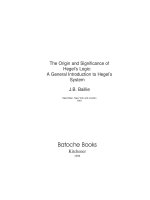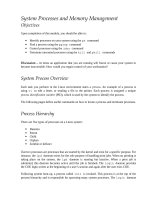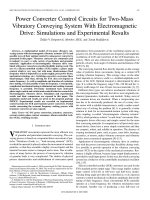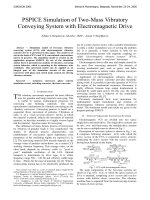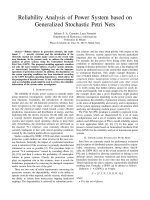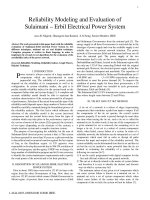Digestive System Processes
Bạn đang xem bản rút gọn của tài liệu. Xem và tải ngay bản đầy đủ của tài liệu tại đây (1.16 MB, 9 trang )
Digestive System Processes
Digestive System Processes
Bởi:
OpenStaxCollege
Obtaining nutrition and energy from food is a multi-step process. For true animals, the
first step is ingestion, the act of taking in food. This is followed by digestion, absorption,
and elimination. In the following sections, each of these steps will be discussed in detail.
Ingestion
The large molecules found in intact food cannot pass through the cell membranes. Food
needs to be broken into smaller particles so that animals can harness the nutrients and
organic molecules. The first step in this process is ingestion. Ingestion is the process
of taking in food through the mouth. In vertebrates, the teeth, saliva, and tongue play
important roles in mastication (preparing the food into bolus). While the food is being
mechanically broken down, the enzymes in saliva begin to chemically process the food
as well. The combined action of these processes modifies the food from large particles
to a soft mass that can be swallowed and can travel the length of the esophagus.
Digestion and Absorption
Digestion is the mechanical and chemical break down of food into small organic
fragments. It is important to break down macromolecules into smaller fragments that
are of suitable size for absorption across the digestive epithelium. Large, complex
molecules of proteins, polysaccharides, and lipids must be reduced to simpler particles
such as simple sugar before they can be absorbed by the digestive epithelial cells.
Different organs play specific roles in the digestive process. The animal diet needs
carbohydrates, protein, and fat, as well as vitamins and inorganic components for
nutritional balance. How each of these components is digested is discussed in the
following sections.
Carbohydrates
The digestion of carbohydrates begins in the mouth. The salivary enzyme amylase
begins the breakdown of food starches into maltose, a disaccharide. As the bolus of food
travels through the esophagus to the stomach, no significant digestion of carbohydrates
takes place. The esophagus produces no digestive enzymes but does produce mucous
1/9
Digestive System Processes
for lubrication. The acidic environment in the stomach stops the action of the amylase
enzyme.
The next step of carbohydrate digestion takes place in the duodenum. Recall that the
chyme from the stomach enters the duodenum and mixes with the digestive secretion
from the pancreas, liver, and gallbladder. Pancreatic juices also contain amylase, which
continues the breakdown of starch and glycogen into maltose, a disaccharide. The
disaccharides are broken down into monosaccharides by enzymes called maltases,
sucrases, and lactases, which are also present in the brush border of the small intestinal
wall. Maltase breaks down maltose into glucose. Other disaccharides, such as sucrose
and lactose are broken down by sucrase and lactase, respectively. Sucrase breaks down
sucrose (or “table sugar”) into glucose and fructose, and lactase breaks down lactose (or
“milk sugar”) into glucose and galactose. The monosaccharides (glucose) thus produced
are absorbed and then can be used in metabolic pathways to harness energy. The
monosaccharides are transported across the intestinal epithelium into the bloodstream to
be transported to the different cells in the body. The steps in carbohydrate digestion are
summarized in [link] and [link].
Digestion of carbohydrates is performed by several enzymes. Starch and glycogen are broken
down into glucose by amylase and maltase. Sucrose (table sugar) and lactose (milk sugar) are
broken down by sucrase and lactase, respectively.
Digestion of
Carbohydrates
Enzyme
Produced By
Site of
Action
Substrate
Acting On
Salivary amylase
Salivary glands
Mouth
Disaccharides
Polysaccharides
(maltose),
(Starch)
oligosaccharides
Pancreatic amylase Pancreas
Oligosaccharidases
Lining of the
intestine; brush
End Products
Disaccharides
Small
Polysaccharides
(maltose),
intestine (starch)
monosaccharides
Small
Disaccharides
intestine
Monosaccharides
(e.g., glucose,
2/9
Digestive System Processes
Digestion of
Carbohydrates
Enzyme
Produced By
border
membrane
Site of
Action
Substrate
Acting On
End Products
fructose,
galactose)
Protein
A large part of protein digestion takes place in the stomach. The enzyme pepsin plays
an important role in the digestion of proteins by breaking down the intact protein
to peptides, which are short chains of four to nine amino acids. In the duodenum,
other enzymes—trypsin, elastase, and chymotrypsin—act on the peptides reducing
them to smaller peptides. Trypsin elastase, carboxypeptidase, and chymotrypsin are
produced by the pancreas and released into the duodenum where they act on the
chyme. Further breakdown of peptides to single amino acids is aided by enzymes
called peptidases (those that break down peptides). Specifically, carboxypeptidase,
dipeptidase, and aminopeptidase play important roles in reducing the peptides to free
amino acids. The amino acids are absorbed into the bloodstream through the small
intestines. The steps in protein digestion are summarized in [link] and [link].
3/9
Digestive System Processes
Protein digestion is a multistep process that begins in the stomach and continues through the
intestines.
Digestion of Protein
Enzyme
Produced By
Site of
Action
Substrate
Acting On
End Products
Pepsin
Stomach
chief cells
Stomach
Proteins
Peptides
Pancreas
Small
intestine
Proteins
Peptides
Pancreas
Small
intestine
Peptides
Amino acids and
peptides
• Trypsin
• Elastase
Chymotrypsin
Carboxypeptidase
4/9
Digestive System Processes
Digestion of Protein
Enzyme
Produced By
• Aminopeptidase Lining of
• Dipeptidase
intestine
Site of
Action
Substrate
Acting On
End Products
Small
intestine
Peptides
Amino acids
Lipids
Lipid digestion begins in the stomach with the aid of lingual lipase and gastric lipase.
However, the bulk of lipid digestion occurs in the small intestine due to pancreatic
lipase. When chyme enters the duodenum, the hormonal responses trigger the release
of bile, which is produced in the liver and stored in the gallbladder. Bile aids in the
digestion of lipids, primarily triglycerides by emulsification. Emulsification is a process
in which large lipid globules are broken down into several small lipid globules. These
small globules are more widely distributed in the chyme rather than forming large
aggregates. Lipids are hydrophobic substances: in the presence of water, they will
aggregate to form globules to minimize exposure to water. Bile contains bile salts,
which are amphipathic, meaning they contain hydrophobic and hydrophilic parts. Thus,
the bile salts hydrophilic side can interface with water on one side and the hydrophobic
side interfaces with lipids on the other. By doing so, bile salts emulsify large lipid
globules into small lipid globules.
Why is emulsification important for digestion of lipids? Pancreatic juices contain
enzymes called lipases (enzymes that break down lipids). If the lipid in the chyme
aggregates into large globules, very little surface area of the lipids is available for
the lipases to act on, leaving lipid digestion incomplete. By forming an emulsion,
bile salts increase the available surface area of the lipids many fold. The pancreatic
lipases can then act on the lipids more efficiently and digest them, as detailed in [link].
Lipases break down the lipids into fatty acids and glycerides. These molecules can pass
through the plasma membrane of the cell and enter the epithelial cells of the intestinal
lining. The bile salts surround long-chain fatty acids and monoglycerides forming tiny
spheres called micelles. The micelles move into the brush border of the small intestine
absorptive cells where the long-chain fatty acids and monoglycerides diffuse out of
the micelles into the absorptive cells leaving the micelles behind in the chyme. The
long-chain fatty acids and monoglycerides recombine in the absorptive cells to form
triglycerides, which aggregate into globules and become coated with proteins. These
large spheres are called chylomicrons. Chylomicrons contain triglycerides, cholesterol,
and other lipids and have proteins on their surface. The surface is also composed of the
hydrophilic phosphate "heads" of phospholipids. Together, they enable the chylomicron
to move in an aqueous environment without exposing the lipids to water. Chylomicrons
5/9
Digestive System Processes
leave the absorptive cells via exocytosis. Chylomicrons enter the lymphatic vessels, and
then enter the blood in the subclavian vein.
Lipids are digested and absorbed in the small intestine.
Vitamins
Vitamins can be either water-soluble or lipid-soluble. Fat soluble vitamins are absorbed
in the same manner as lipids. It is important to consume some amount of dietary lipid
to aid the absorption of lipid-soluble vitamins. Water-soluble vitamins can be directly
absorbed into the bloodstream from the intestine.
Link to Learning
6/9
Digestive System Processes
This website has an overview of the digestion of protein, fat, and carbohydrates.
Art Connection
Mechanical and chemical digestion of food takes place in many steps, beginning in the mouth
and ending in the rectum.
Which of the following statements about digestive processes is true?
1.
2.
3.
4.
Amylase, maltase, and lactase in the mouth digest carbohydrates.
Trypsin and lipase in the stomach digest protein.
Bile emulsifies lipids in the small intestine.
No food is absorbed until the small intestine.
Elimination
The final step in digestion is the elimination of undigested food content and waste
products. The undigested food material enters the colon, where most of the water is
reabsorbed. Recall that the colon is also home to the microflora called “intestinal flora”
that aid in the digestion process. The semi-solid waste is moved through the colon by
7/9
Digestive System Processes
peristaltic movements of the muscle and is stored in the rectum. As the rectum expands
in response to storage of fecal matter, it triggers the neural signals required to set up
the urge to eliminate. The solid waste is eliminated through the anus using peristaltic
movements of the rectum.
Common Problems with Elimination
Diarrhea and constipation are some of the most common health concerns that affect
digestion. Constipation is a condition where the feces are hardened because of excess
water removal in the colon. In contrast, if enough water is not removed from the feces,
it results in diarrhea. Many bacteria, including the ones that cause cholera, affect the
proteins involved in water reabsorption in the colon and result in excessive diarrhea.
Emesis
Emesis, or vomiting, is elimination of food by forceful expulsion through the mouth. It
is often in response to an irritant that affects the digestive tract, including but not limited
to viruses, bacteria, emotions, sights, and food poisoning. This forceful expulsion of the
food is due to the strong contractions produced by the stomach muscles. The process of
emesis is regulated by the medulla.
Section Summary
Digestion begins with ingestion, where the food is taken in the mouth. Digestion and
absorption take place in a series of steps with special enzymes playing important
roles in digesting carbohydrates, proteins, and lipids. Elimination describes removal of
undigested food contents and waste products from the body. While most absorption
occurs in the small intestines, the large intestine is responsible for the final removal of
water that remains after the absorptive process of the small intestines. The cells that line
the large intestine absorb some vitamins as well as any leftover salts and water. The
large intestine (colon) is also where feces is formed.
Art Connections
[link] Which of the following statements about digestive processes is true?
1.
2.
3.
4.
Amylase, maltase and lactase in the mouth digest carbohydrates.
Trypsin and lipase in the stomach digest protein.
Bile emulsifies lipids in the small intestine.
No food is absorbed until the small intestine.
[link] C
8/9
Digestive System Processes
Review Questions
Where does the majority of protein digestion take place?
1.
2.
3.
4.
stomach
duodenum
mouth
jejunum
A
Lipases are enzymes that break down ________.
1.
2.
3.
4.
disaccharides
lipids
proteins
cellulose
B
Free Response
Explain why some dietary lipid is a necessary part of a balanced diet.
Lipids add flavor to food and promote a sense of satiety or fullness. Fatty foods are
sources of high energy; one gram of lipid contains nine calories. Lipids are also required
in the diet to aid the absorption of lipid-soluble vitamins and for the production of lipidsoluble hormones.
9/9
